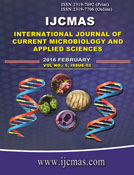


 National Academy of Agricultural Sciences (NAAS)
National Academy of Agricultural Sciences (NAAS)

|
PRINT ISSN : 2319-7692
Online ISSN : 2319-7706 Issues : 12 per year Publisher : Excellent Publishers Email : editorijcmas@gmail.com / submit@ijcmas.com Editor-in-chief: Dr.M.Prakash Index Copernicus ICV 2018: 95.39 NAAS RATING 2020: 5.38 |
The main objective of this study was to determine the prevalence, risk factors and antimicrobial susceptibility of Beta lactamase (BL) producing Enterobacteriacea isolated from CAUTI and Non-CAUTI patients. This study was conducted at Dawadmi General Hospital, Saudi Arabia from March 2012 to March 2015. A total of 780 urine samples were collected from mid-stream, clean catch, suprapubic aspirate and Foley’s catheter from both inpatient and outpatient departments for studying the presence of Beta lactamase enzymes producing Enterobacteriacea. The organisms were isolated by standard microbiological techniques and the isolates were tested for their species identification and antimicrobial susceptibility by modified Vitek 2 method. Out of the total 780 urine samples collected in this study, 388 (49.7%) came out to be positive for UTI isolates. Among them 231 (29.6%) isolates recovered were found to be Enterobacteriacea. Among Enterobacteriacea 150 (64.9%) isolates were producing beta lactamases and 81 (35.1%) isolates were non-beta lactamases. The risk factors in Beta lactamase isolates were found to be long term hospital stay 134(89.3%), urinary catheter 125(83.3%), ICU stay 109(72.7%), prior antibiotic use within 3 months 98(65.3%), obstructive uropathy 74(46.7%), renal disease/renal transplant 68(45.3%).The frequency of ESBL, CTX-M, AmpC, ESBL with Carbapenems, OXA and MBL were higher in catheterized patients as compared to non-catheterized patients. The β-lactamases producing isolates were resistant to most of the antibiotics tested but Tigecycline and Colistin showed promising efficacy against all the Beta lactamases in both CAUTI patients and Non-CAUTI patients Catheterized patients should be screened regularly for the prevalence beta lactamase producers. While handling catheterized patients the healthcare staff should follow proper guidelines and infection control measures to avoid the spread of nosocomial infections.
 |
 |
 |
 |
 |